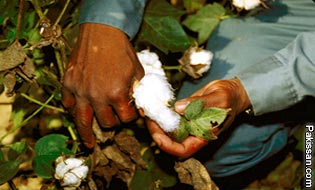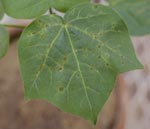|
Red-leaf-disease in
Sindh cotton belt
By Shaukat Ali
Bhambhro
The share of Sindh in cotton production is about 20 per cent.
According to the Crop Management Committee, cotton cultivation
in the province has been recorded on 611,000 hectares this
year which is 21,000 hectares more than the target fixed by
the federal government.
 Recently, a meeting was chaired by the Sindh Agriculture
Minister, Arif Mustafa Jatoi, which termed the standing crop
as satisfactory, and the pest attack negligible. Contrary to
last year, this year the two pests american and army worms
have remained at low ebb. Recently, a meeting was chaired by the Sindh Agriculture
Minister, Arif Mustafa Jatoi, which termed the standing crop
as satisfactory, and the pest attack negligible. Contrary to
last year, this year the two pests american and army worms
have remained at low ebb.
Only spotted bollworm has shown its appearance warranting
control measures, hitherto. The absence of monsoon rains in
the upper Sindh cotton belt proved a blessing for growers.
Almost 70 to 80 per cent growers in the districts of Ghotki,
Sukkur, Khairpur and Naushero Feroze have switched over from
the old Niab-78, the CIM-109, the SLS-1 to the highly
susceptible new cotton varieties.
Those are not yet approved, but are on trial by the Punjab
cotton breeders. These varieties are big belled with big
leaves and prone to bollworms attack, especially the american
and army worms.
Some new cotton varieties from Punjab introduced in upper
Sindh by the mafia, and under the defective Seed Certification
Act of 1976 are the CIM-499, the CIM-1000, the CIM- 496, the
CIM-511, the CIM-506, the VH-1 37, NIAB-111 etc. The CIM-473
is also a big boll variety, approved by the Sindh Agriculture
Department.
Last year's Kharif, varieties especially the FH-1000 and the
CIM-499, due to heavy monsoon rains required 10 to 12 sprays
against the pests, especially army worms and american boll
worms.
Pests prone varieties are not suitable for financially
constrained growers of Sindh because majority of growers
purchase inputs like seeds, fertilizers and pesticides on
credit of which interest rates are excessively high up to 40
per cent only for six months.
Accordingly 10 sprays cost as much as 20 sprays which is
unaffordable for the growers. Despite these realities there
seems to be no strategy to bring a change in the existing
free- for-all-like situation where the sale of imperious
pesticides, fertilizers, seeds, micronuitriants etc., are
rampant. Today agriculture sector in Sindh is like a ship
without the rudder.
Best example is the present outbreak of red-leaf-disease of
cotton which has spread over 25 Dehs of District Khairpur and
Naushero Feroze affecting about 4,000 acres of standing crop.
+AB0- +AAA- Insurgence of this disease came to the notice of
Secretary Agriculture, Sindh, not through the field force of
the Agriculture Extension but through local newspaper reports
initiated by a Khairpur-based NGO (RADO).
According to Saffartunio and Dr Fateh Memon of this NGO, who
are also cotton growers, symptoms of this disease were
observed about 10 days back. But just after 4-5 days their
entire cotton fields become red followed by drying of the
plants.
 The writer personally surveyed some affected Dehs in Taluka
Sobhodero, District Khairpur and Taluka Kandiaro of District
Naushero Feroze. Observation recorded during the survey are as
follows: The writer personally surveyed some affected Dehs in Taluka
Sobhodero, District Khairpur and Taluka Kandiaro of District
Naushero Feroze. Observation recorded during the survey are as
follows:
1. About 70 to 80 per cent affected crops were early sown with
20 to 30 per cent opening of mature bolls.
2. Premature drying of plant following outbreak of the said
disease may cause 15 to 20 per cent yield loss.
3. Besides the red-leaf-disease, field inspection also
revealed presence of termites, ring rot and mites infection.
However, red-leaf-disease was the dominant factor behind the
crop damage.
4. Among the red-leaf-plants some cotton plants of different
variety were green which indicated that some variety is
resistant to red-leaf-disease.
However, majority of the newly introduced varieties like the
CIM-496, the CIM-499, the CIM-506 etc., were found susceptible
to this disease. It would be proper to mention that the
CIM-446 variety whose cultivation was allowed in late 1990's
following introduction of the CLCV disease in the upper Sindh
region was also found under red-leaf-disease.
5. Red-leaf-disease, being a physiological phenomenon, is not
new. Its occurrence is common in the deserts cotton belt of
Taluka Nara. It occurs mainly when the application of urea
fertilizer is cut off in August or when there is water
scarcity. Few days back a progressive grower of Farare Taluka
Nara apprised to this scribe that with four bags of urea
fertilizer and two bags of DAP he is expecting about 40 mounds
yield per acre with the CIM-496 variety. However, he confirmed
five sprays against two to three sprays on the CIM-109, which
is still, a popular variety in the desert cotton belt of Nara
despite its susceptibility to the CLCVD.
The most important information provided by the said grower
about the CIM-496 variety was its poor tolerance to water
stressing as well as excessive irrigation.
SUGGESTIONS: Since reddening of leaves may be due to some
other factor or disease it is suggested that the Cotton
Commissioner may constitute a team of experts comprising
pathologist and cotton breeder, especially from the Cotton
Research Institute Multan for detail survey of the affected
area and necessary recommendations for protection of late sown
standing crop in the +AB0- +AAA- upper Sindh region and also
for next year crop.
Courtesy:The
DAWN |
Pakissan.com;
|